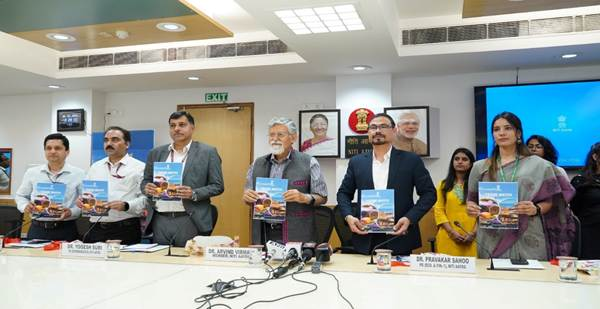India’s Trade Performance Holds Steady; NITI Aayog Releases Q2 FY’25 Trade Watch Quarterly
This edition presents a meticulous analysis of India's trade performance for the quarter, highlighting economic trends, emerging sectoral dynamics, and the global positioning of Indian trade.

- Country:
- India
Dr. Arvind Virmani, Hon'ble Member of NITI Aayog, officially released the second edition of the "Trade Watch Quarterly" publication for Quarter II of the financial year 2025 (July to September). The launch event in New Delhi underscored India’s evolving trade landscape and provided a deep dive into the nation’s export-import trends, with a special focus on the textile sector.
This edition presents a meticulous analysis of India's trade performance for the quarter, highlighting economic trends, emerging sectoral dynamics, and the global positioning of Indian trade. A key feature of this edition is its in-depth assessment of the textile industry, a sector integral to India’s economic framework due to its substantial contributions to export promotion, employment generation, and women's empowerment. The textile sector also plays a vital role in showcasing India’s rich heritage and cultural diversity on a global scale.
India’s Trade Performance in Q2 FY’25
During the second quarter of FY’25, India's trade performance remained resilient, with total trade growing steadily at 5.67% in April–September 2024 compared to the same period in 2023. The stable trade performance reflects the nation’s ability to navigate global economic shifts while sustaining positive growth momentum.
On the imports front, a notable shift was observed, with copper emerging among the top ten imported commodities, driven by a 28% year-on-year growth in imports. This increase is largely attributed to rising infrastructure demand and India’s push toward strengthening its industrial base.
The export composition has remained relatively stable compared to the previous quarter. Noteworthy developments include a year-on-year increase in the export growth of electrical machinery and nuclear reactors, signifying the continued advancement of India’s industrial and technological capabilities. However, sectors such as mineral fuels and iron & steel recorded a decline in export performance compared to Q2 FY’24.
From a regional perspective, North America and the European Union remain the dominant destinations for Indian exports, accounting for approximately 40% of total outbound shipments. On the import side, Northeast Asia and West Asia continue to be key suppliers of essential goods and raw materials.
A Special Focus on India’s Textile Sector
The textile industry, a cornerstone of India’s industrial economy, was given special attention in this edition of Trade Watch Quarterly. India is among the top 10 textile exporters globally, holding a modest 4% share in the global trade of textiles and apparel. Despite this, the sector faces both challenges and opportunities in an evolving international market.
Historically, India has maintained a competitive edge in natural fibre-based textiles, particularly cotton-based fabrics, garments, and carpets, which together account for nearly 70% of the nation’s textile exports. However, global demand patterns are undergoing a fundamental shift, with an increasing focus on man-made and technical textiles.
The demand for technical textiles—used in sectors such as healthcare, automotive, construction, and defense—has been on the rise. Countries like China, the United States, and Germany have aggressively expanded their production capacities to cater to this demand. For India, this represents an opportunity to diversify its textile exports, enhance value addition, and strengthen supply chain integration to remain competitive in the global market.
Dr. Virmani’s Address at the Launch Event
Speaking at the launch, Dr. Arvind Virmani lauded the efforts of the team behind the publication and reiterated the importance of adaptive trade policies to align with emerging global trends.
"The future belongs to economies that embrace transformation, and India’s trade landscape is evolving with bold strides. Among its key industries, the textile sector stands as a pillar of India's industrial growth and global trade competitiveness," said Dr. Virmani.
He emphasized the need for India to closely monitor the rising global demand for technical textiles and apparel exports, as a substantial portion of this demand is concentrated in advanced economies. He also highlighted the importance of geopolitical awareness and strategic trade planning, especially in light of ongoing economic realignments worldwide.
Additionally, Dr. Virmani noted that the insights from the Trade Watch Quarterly serve as an invaluable resource for policymakers, industry leaders, and academicians, helping to refine India’s trade strategies and enhance the country’s global standing.
Future Outlook for India’s Trade Growth
As India continues its journey towards a $5 trillion economy, the role of exports and trade-driven growth will remain pivotal. Key areas for future improvement and policy intervention include:
-
Strengthening supply chain resilience to mitigate global disruptions.
-
Enhancing manufacturing competitiveness through innovation and technology.
-
Diversifying export destinations beyond traditional markets.
-
Fostering public-private collaboration in high-growth industries like textiles, electronics, and pharmaceuticals.
-
Expanding trade agreements to facilitate smoother global market access.
The second edition of the Trade Watch Quarterly is poised to provide stakeholders with the necessary insights to navigate the complexities of international trade and shape strategic trade policies that will propel India toward greater economic prosperity.
About Trade Watch Quarterly: Trade Watch Quarterly is an analytical publication that provides an in-depth review of India’s trade performance across various sectors, tracking emerging trends and offering insights for policymakers, businesses, and industry leaders. The publication is an initiative by NITI Aayog aimed at enhancing India's global trade strategies.
- READ MORE ON:
- Trade Watch Quarterly
- NITI Aayog
- Dr. Arvind Virmani










